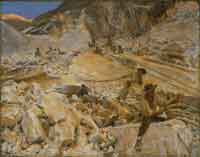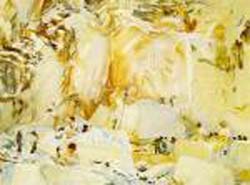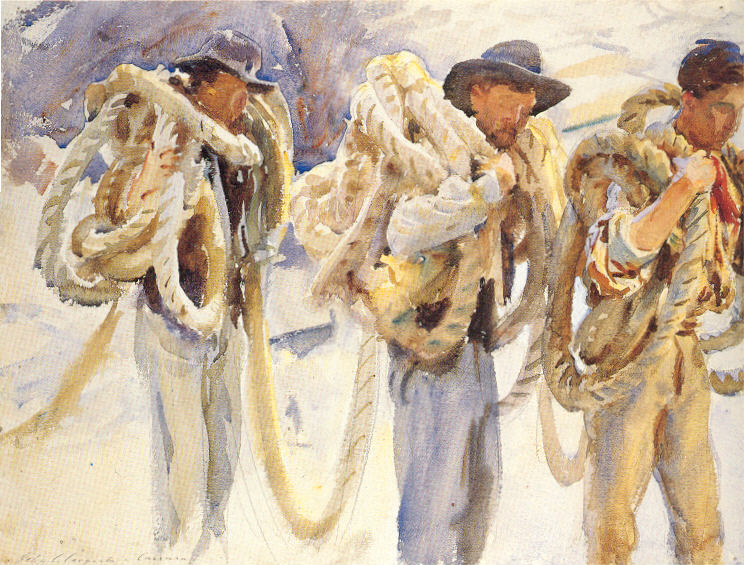Workman
at Carrara
c. 1911
The
Art Institute of
Chicago, IL
Watercolor
and pencil
on paper
39.4 x
52.1 cm (15 1/2 x 20 1/2
in.)
Olivia
Shaler Swan Collection
Jpg: local source
In the first study to
the right, you can see men hauling ropes up the side of mountain
steps. This is
similar to the watercolor Carrara, Lizzatori I (though you
can't
see the men very well in the thumbnail). In that painting, the men are
further
up the steps.
These
workmen who apparently are called "lizzatori", cut the huge blocks and
then


Bringing
down Marble from the Quarries to Carrar

|
 |
manually tie them
with these massive hemp ropes, using what I
assume
to be block-and-tackle with wrenches along with sheer brute force to
amazingly
haul, drag, pull these immense stones down the mountain.
In Sargent’s series
of paintings,
you can clearly sense the harsh climate they are working in. Bringing
down Marble (above) is one of only two known oils, you can see the


Carrara:
Monsieur Derville's Quarry

|
 |
stunning contrast
between the angular, unforgiving rock, to the
rounded,
pliable bodies, ropes,
and clothing. In Carrara: Monsieur
Derville's Quarry (left),
we
see the devouring sun beating down diluting all shades of color to a
monocrome tonal-range. In Carrara: A Quarry (lower
right),
four men chip away at a massive block on a plateau of the imposing
mountain
in the lower part of the painting. Their bodies
are nearly lost and only
suggested with
smudges of brown, the far right
man using some sort of pole as leverage to shift the massive rock. We
find
them insignificant in their jagged world. Annette Blaugrund,
in her essay called
“Sunshine Captured . . .” says that the paintings done at Carrara show
Sargent working in a tour de force of watercolor techniques from
"scraping,
wiping out, and waxing, used in combination with gouache and
transparent
layering to achieve
the glistening
effects of sunlight
on stone” (p.
231, JSS, Patricia Hills book)
As I view these
images I’m reminded
of my own trips to the southwest of the United States, the sort of
arid,
dry, rocky paths up small mountains (really nothing more than large
hills).
I remember the sun would very much wash everything out.
Looking at these
images you can almost
hear the crunch
of gravel under boot, the ping of steel chisels cutting away chips of
jagged
earth, the groan of
hemp rope
taut around wooden creaking wrenches, and
the reluctant guttural moan -- stone against stone -- of boulders
pulled
from eternal slumber; and if you look close enough, take the time to
see
the world that Sargent saw, you can almost taste the gritty stone-dust
between your teeth, feel the burn of sun on your skin, and the soaked
salty
bandana hanging heavy around your neck.
I think I need a
glass of water.
Notes:
Exhibitions
John
Singer
Sargent,
An Exhibition -- Whitney
Museum, NY & The Art Institute of Chicago 1986-1987
Forum
From: Mario
Venutelli
<marve nu
telli@tiscali.it>
Date: Friday, December
19, 2003
[english
translation]
Complimenti per il suo
meraviglioso
lavoro!
La prego di darmi ogni
ulteriore
indicazione sulle opere di Sargent che hanno riguardato le cave di
marmo
di Carrara (Italia) ed eventuali informazioni sul suo soggiorno a
Carrara.
So di chiederLe
molto e Le sarò
infinitamente grato. Stiamo preparando una conferenza su Sargent a
Carrara
e abbiamo bisogno di tutti i libri e di tutte le notizie relative.
Siamo,
quindi, disponibili ad acquistare le sue ed altre pubblicazioni in
merito...
Grazie infinite e
Buone Feste dalla
città del
Marmo e della Scultura.
Mario Venutelli
Via Alessandro
Manzoni, 5 54033
CARRARA (MS)
ITALIA
Editor's English
Translation
Compliments for a
wonderful job!
I pray that you might be able to give an indication to me on the works
of Sargent that regard the quarry of marble of Carrara (Italy) and any
information on his stay at Carrara. I know this is asking a lot but
would
be infinitely grateful.
We are preparing
a conference on
Sargent for Carrara and have need of all the books and all the relevant
information so that we can acquire these and other publications of
merit.
Infinite thanks
and Happy Festivities
from the city of Marble and Sculpture.
Mario
Venutelli
Via Alessandro
Manzoni, 5 54033
CARRARA (MS) ITALY]
From: Natasha
Very little is
known, that I know
anyway, WHY Sargent choose Carrara and the marble quarry for what would
be one of the most tightly grouped series of paintings that he would
ever
do.
There is, of
course, the Venetian
Studies of pedestrian scenes and the paintings and drawings during
the war in France in
1918. There is the series of mountain scenes in the alps over a
period
of years, but Carrara really stands out as the tightest grouping of
paintings
in a theme that Sargent ever did.
What do I know
about them? Very little.
Sargent apparently loved the lighting, and I think he expressed that to
someone but I have gone through my literature here (of what I have
anyway)
and I can't find were I read that. In fact, two of the main
biographies: Stanley
Olson's 'John
Singer Sargent, His Portrait'; St. Martin's Press, New York, 1886;
and Evan Charteris' 'John Sargent'; Benjamin Blom, Inc, New York, 1925
both maddeningly scarcely mention Carrara
Much of the
literature regarding
Carrara, that I can find, spend all their time on personal
interpretation
and reiteration in words what Sargent painted on paper and canvas
-- a practice that is often done by art historians -- as if you needed
to be told what you are looking at -- I did it even -- I think it is
all they can do
when apparently we know so little about the WHY he went there, WHERE he
stayed, WHAT his intent was etc.
There isn't any
particular book that
doesn't give more than just a couple of pictures of his Carrara work.
Even
'Sargent
Abroad,
Figures and Landscapes', Abbeville Press, New York, London and
Paris,
1997 only show the two oils and one photograph.
I don't know how
much time you have,
but your best bet would be to get in touch with Richard Ormond (a
descendent of Sargent's family) but unfortunately, I don't know how to
do that. Maybe through Yale University Press which publishes a lot of
his
books or through Adelson
Galleries which knows how to get a hold of him.
Sargent made two
oil paintings of
the Carrara quarry:
Then something like 17
loosely painted
watercolors that are incredibly powerful in their skill.
Many of the
watercolors are at the
Fine Arts Museum in Boston. The Fogg Art Museum, at Harvard also has a
number of sketches -- I would contact both of those institutions
|






